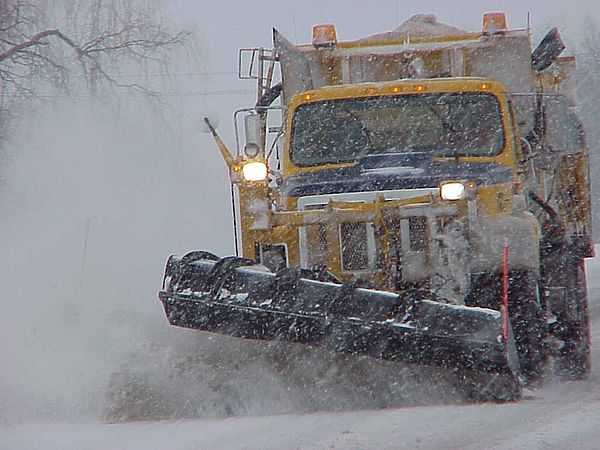It’s snow season. Diligent public works employees spend hours clearing snow and applying salt and sand to roads in order to make daily commutes safer. But eventually, when the snow melts, the sand and salt flows into that river and Lake Champlain. How does it affect water quality?
Road salt has been employed to melt ice on roads in the U.S. since at least the 1930s. The Salt Institute reports use has climbed from 200,000 tons per year in 1940 to 10 to 20 million tons per year more recently.
The salt acts to lower the freezing point of the ice. As the salt dissolves in the film of water at the ice surface it prevents water molecules from rejoining with one another. If it is too cold however, the ice will form regardless of the salt. Typical road salt promotes ice melting down to about 15 0 F, but becomes less efficient at lower temperatures.
The component of road salt most likely to enter surface waters is chlorine in its ionized form (chloride). When salts dissolve they break into positive and negative ions, with chloride being the most common negative ion. The positive ions are more likely to become attached to soil particles, so frequently only the negative chloride remains with the water of melting snow. Vermont and New York both have standards for acceptable levels of chloride in surface waters, with Vermont's standard only having been adopted recently.
High chloride concentrations can have negative effects on water quality. Impacts include increased salinity of ground and surface water, changes in soil properties leading to increased erosion and runoff, water stress and nutrient imbalances for roadside plants, and increased corrosion of automobiles and highway components. In drinking water chlorine can affect taste, and chloride concentrations in drinking water systems should not exceed 250 mg/L.
Chloride concentrations in Lake Champlain are nowhere near that high, however they have been increasing. Concentrations have increased at 11 of 14 monitoring stations. Chloride levels have also increased in five of nine rivers in Vermont and all eight rivers in New York that drain to Lake Champlain. The highest chloride levels have been found in the LaPlatte River.
Examining average chloride concentrations may not be the best way to consider the potential impacts of road salt on water bodies. Of greater concern are the high concentrations that can enter waterbodies during snow melts. Chloride concentrations as high as 2,000 mg/L have been recorded during such events.
Rapid melting of winter’s snow presents a serious challenge to aquatic biota, particularly for smaller waterbodies. In addition to potentially high chloride concentrations, large accumulations of snow contain the oils, grease and debris typical of urban stormwater. To avoid these problems snow should be stored in places where the water generated will have a chance to be filtered through soil before reaching waterbodies. Additionally, salt does not move quickly out of the environment. Stuart Findley of the Cary Institute for Ecosystem Studies has found especially high chloride levels in the water in August, which is when groundwater would be the main source for streams and rivers. It can take decades for road salt to flush out of a watershed so salt increases in waterways may continue to show up even after salt use has stopped or declined significantly.
Probably the best way to limit any negative ecological effects of road salt is to minimize use, which also saves on municipal budgets. The salt can be applied as a brine, road salt mixed with water, a strategy employed by both Vermont and New York Departments of Transportation. Brine prevents ice from forming on roads when applied prior to storms, and is effective at lower temperatures. It also sticks to the road better than solid salt, and can be applied to multiple road lanes with one pass. Targeted salt application can reduce the quantities needed to achieve the same result. With conventional rotary salt spreaders, over 30 percent of the product can be wasted as it bounces off of the target roadways. On less traveled roads, crews can apply deicers in concentrated strips in the middle of the road. As the ice on the strip melts the pavement beneath is exposed to sun and can warm up to assist melting of the rest of the road. Zero-velocity spreaders can be used to “place” deicer on roads rather than broadcast spreading.
There are alternatives to traditional road salt. Chemical alternatives include calcium magnesium acetate and urea. These are less toxic, but contain phosphorus or nitrogen that exacerbate our summer algae blooms. They are also substantially more expensive than road salt. Other chloride salts like magnesium chloride or calcium chloride melt more ice per unit used, but they too are more costly.
Sand is sometimes considered an alternative to salt. Sand can improve traction for feet and tires but it does not help melt ice the way salt does. Large quantities of sand washing into rivers and lakes can be even more damaging to aquatic life than salt.
So long as we have winter we’ll have snow, but drivers shouldn't expect bare roads during the winter. An expectation of bare roads creates unrealistic demands on road crews, municipal budgets, and the environment. Road salt can be part of our response to winter weather without unduly impacting water quality, but efforts to minimize its use are warranted. Slowing down during winter driving is part of the solution.
